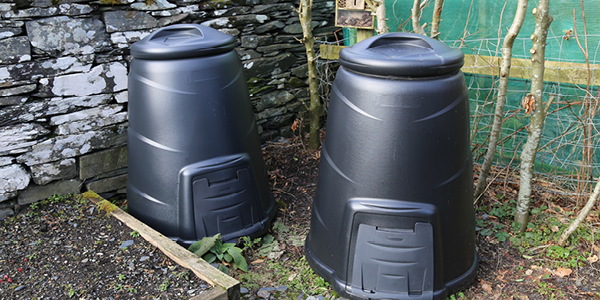Whether you’re new to composting or have a few seasons under your belt, composting in the winter presents challenges in cold climates. Here are some tips to keep your pile hot during the winter.
Use the Fall to Prepare
Fall is the time to collect leaves to store over winter to use as “browns” for your compost throughout the winter and spring. Don’t miss the opportunity to collect your own leaves or ask a neighbor who has an excess. Leaves add an important dry carbon source to balance out the wet, nitrogen-rich greens coming from your kitchen food scraps. Browns provide both energy and aeration to your pile making sure that the microorganisms have oxygen to breathe while they eat. Too little brown material and your pile will become stinky (anaerobic) and cool off so much that the composting process will stop. A good mix of browns to greens is a 2:1 – 3:1 ratio that keep your pile about as wet as a damp sponge. Good aeration in your pile is actually more important than turning it (although you should still do the latter once a week) so don’t miss your opportunity to build up your leaf store this fall.
Keep Your Pile Hot
A good compost pile runs hot (between 141°F – 155°F). Here are some tips to keep it going even when the temps plummet:
- Cover it – Excess water can cool off your pile and create an environment that’s too wet for aerobic (oxygen-loving) bacteria to thrive and do their work. Placing a tarp over your compost pile or tumbler if it isn’t watertight, will help your pile stay hot.
- Break up your food scraps – Breaking up your scraps into smaller pieces will result in your pile heating to the desired temperature more uniformly. A rule of thumb is that the greater the surface area, the higher the rate of decomposition. So, food scraps cut into smaller pieces will compost faster than large pieces. That’s true in any weather conditions.
- Build up your pile – The bigger your pile, the better ability it has to stay warm over the winter and continue to break down. The recommended size for a compost pile is at least 1 cubic yard (3’ft x3’ft x 3’ft). If your pile is smaller, expect that it will cool off over the winter. This means that any material you add in the winter may sit until temperatures warm up in spring.
Turn your compost regularly
Turning your compost pile not only helps the material inside of it break down at an even rate, it provides an added benefit during the winter of deterring rodents. Compost piles are often warm and located in an undisturbed area of your yard. For those reasons, rodents can be especially attracted to compost piles in the colder months.
Consider an alternative method
If composting food scraps at home just isn’t an option, consider other ways to compost organics. Alternatives include using a Community Food Waste Drop-Off site or composting at home with vermicomposting or Bokashi composting.
Happy composting and keep in mind we’re here to answer your food waste and composting questions. Reach out to foodwaste@swaco.org.
